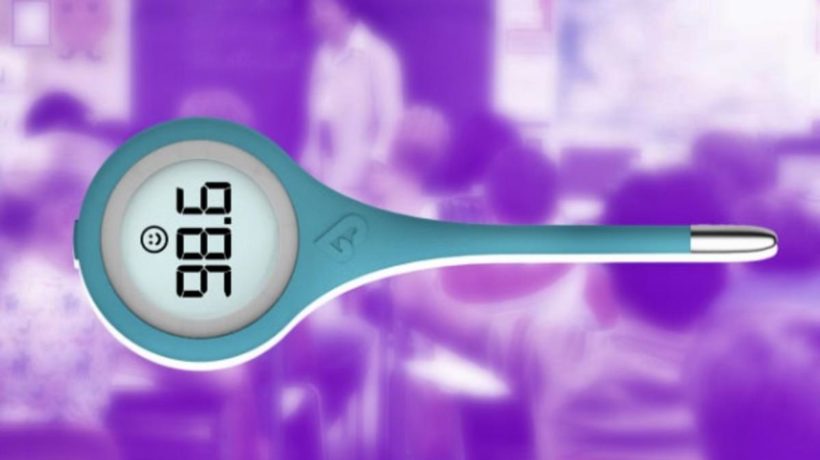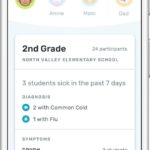On a Friday in November, Alisha Palmer, a school nurse at Jackson Park Elementary in the US, noticed a few kids in the third grade were sent home with high fevers. By Monday morning, it was clear a virus had struck.
It was “some kind of third grade plague,” she says.
Palmer could see the outbreak of fevers in her nurses’ portal, which was provided by a smart thermometer company called Kinsa. Through Kinsa’s FLUency program, each family is sent a thermometer for use at home. If a child is feeling sick, a parent can check their temperature, as they normally might, before they make a decision about sending their child into school. Temperatures are sent from the thermometer over to a corresponding app, where parents can add symptoms and communicate with school nurses.

A dashboard, available to both parents and school nurses like Palmer, reveals illness trends at their school. The data is anonymised so the adults only see the number of students with symptoms and fevers for each grade. A parent can also voluntarily identify that their child is sick to a school nurse. The data allows parents to make more informed decisions about whether or not their kid should stay home from school even if they don’t have a fever. If they see their child has a bad cough and other students in the grade have sore throats, they might opt to keep their kid home.
The third grade plague hit during peak flu season, so the kids that stayed home on Friday went to the doctor and took a flu test. They all came back negative. It appeared to be some kind of virus with very flu-like symptoms.
That Monday, Palmer saw more fevers across the third grade in her dashboard. She grabbed all the thermometers she had in the office and went over to the third grade hallway. The students were just coming in. She armed teachers with thermometers and together they took temperatures for all 75 kids. Anyone who had a temperature of 37.6 degrees Celsius or above went down to the nurse’s office. There, Palmer gave the students full assessments, asking for any symptoms they were feeling. After 15 minutes, she rechecked temperatures. Those with no symptoms and no fever more than 38 degrees went back to class. Everyone else went home. She says she sent home 17 kids that day.
“The kids were not on medication, they were acting totally normal,” she says. If it had not been for her student health portal, she wouldn’t have learned that many of them were running around with fevers.
As COVID-19 continues to spread across the U.S., public health experts have been debating the merits of reopening schools. A recent study shows that children, who often only exhibit mild to no symptoms when infected with COVID-19, have lots of opportunity to transmit the virus at school. As a result, some epidemiologists think that it’s too early to bring students back into schools. But experts on childhood education think that keeping kids home is also damaging, since kids could be falling behind on learning and missing out on critical social experiences. So far, suggestions for how to welcome students back into school include strict social distancing rules and allowing teachers and students with preexisting health conditions to continue working from home. But the early success of Kinsa’s FLUency program suggests that health surveillance could also play a vital role.
“From a public health standpoint, understanding if [a disease] is coming from one grade or one classroom—where we know the kids are clustering together—helps you stem a potential outbreak of flu or another virus,” says Ishani Ganguli, an assistant professor of medicine at Harvard Medical School and a primary care physician at Brigham and Women’s Hospital, who researches pediatric and primary care models. She also cautions that data accuracy in such a scheme would be extremely important, because false positives dictate whether someone unnecessarily misses out on school (and whether a parent unnecessarily misses out on work).
Kinsa has been tracking and modeling the spread of annual flu viruses for the last few years, and its results have been in line with that of the Centers for Disease Control and Prevention. The company is able to predict how the flu will travel two to three weeks ahead of time. Kinsa is also tracking the trajectory of COVID-19 using its smart thermometers. This year, Kinsa will be partnering with 10% of elementary schools around the country to implement its FLUency program.
“In my experience as a doctor, I am always struck by how few people have thermometers at home,” says Ganguli. “So just the notion of distributing these widely to people is awesome.”
MANAGING PUBLIC HEALTH AT SCHOOL
Jackson Park Elementary is a small school of 470 students, most of whom come from families that don’t earn a lot of money. For the parents, caring for sick kids is often a difficult choice between losing a day of pay and ensuring their child is healthy.
“Our [families] often don’t have cars, they often can’t get to the doctor, maybe only one parent works,” Palmer says. When she started working there in 2016, she says she would see 50 kids a day. “A lot of kids were lining up in my office and saying, ‘Mom checked my temperature, she didn’t know if she should take me to the doctor or not—she wanted you to check.’” That often meant kids were often coming into school sick and then infecting their classmates.
But in 2017, the school implemented Kinsa’s FLUency program, which is designed specifically for Title 1 schools, or schools with a high number of low-income students.
Palmer says that after launching the program, the number of kids she saw everyday went down dramatically year over year. “I was talking with one of the other nurses and I said, ‘Our director is not going to think I’m logging the children correctly, because these numbers are so drastically different.’”
She says the program gave parents a lot more information so they could understand when their child was actually sick and make better decisions about when to take off of work. By 2018, she was only seeing 25 kids a day.
When Palmer and I spoke in March, her school had just been shut down in response to the coronavirus. She says that during that time she was able to communicate with parents through the app either about individual cases or just to send out information she was receiving from the county health department. It has proven an important platform for the school in helping parents to manage their children’s health.
“We can do that on a larger scale,” says Inder Singh, the CEO of Kinsa. “Imagine a county health commissioner being able to communicate out health information with their county participants.” The company’s thermometers are widely available in stores like Walmart and the company is testing its ability to accurately follow and predict the trajectory of COVID-19 based on temperature data. But to roll out its coordinated health platform widely in schools would require a much larger supply of its thermometers than it may currently have.
The company is already thinking about how to expand its program from several counties to a whole state. Two assistant professors at the University of Arkansas Medical Sciences and codirectors of clinical informatics at the school’s Institute for Digital Health & Innovation have been in conversation with Kinsa about opportunities for using the FLUency program throughout Arkansas.
“We’d love to do a statewide student population,” says Joseph Sanford, one of the codirectors. He and his codirector Kevin Sexton say there are a lot of things about FLUency that make it an attractive public health solution. Beyond being easy to find in stores and online, Kinsa’s thermometer only costs $20. In addition, people are already used to taking their temperature with a thermometer when they feel sick so there’s no new behavior to learn. Plus, the system isn’t entirely automated—the school nurse provides a necessary human component, since they can advise on whether students should stay home and go to the doctor or come into school.
Using fever as a metric to track illness is also an advantage. Other symptoms, Sexton says, are not as clean. “Cough, for example, has a ton of other explanations,” says Sexton.
He also notes that illness is the leading cause of absenteeism. Stopping sick kids from going to school reduces the total number that ultimately miss out on school days. The FLUency program has also already proved capable of helping curb flu transmission at the local level at school’s like Jackson Park Elementary. Of course, in order for the Kinsa platform to work effectively, everyone at a school has to use it, which will require broad buy-in from parents. Still, Sanford thinks that people may be more inclined to participate in such a program as they consider managing COVID-19 risk when schools reopen.
“In the post-COVID era, we have an enormous opportunity to do viral season screenings,” says Sanford.
Article originally published on fastcompany.com.









